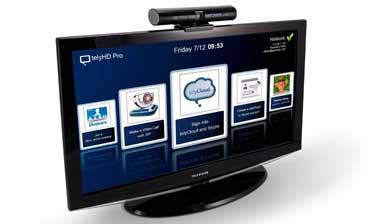Review: TelyHD Pro Is a Capable, Self-Contained Skype Appliance For SMBs

If your customers have complained about meeting delays because no one could figure out how to work the teleconferencing system you supplied, then you might consider the $649 TelyHD Pro from TelyLabs. After reviewing this simple SIP/VoIP unit, the CRN Test Center was impressed with its quick setup, ease of use and feature richness of a device costing less than the HDTV we tested it on.
Out of the box, the footlong bar turns any HDMI-equipped monitor or television into "Number Five," the robot character from the 1986 sci-fi romp "Short Circuit." Plugging in the included HDMI cable and AC adapter, the unit boots in about two minutes and is ready to configure. An automatic firmware update and installation added another five, bringing the total time from out-of-box to videoconferencing to less than 10 minutes.
A small remote provides simple four-arrow navigation with a central select button and additional controls for menu and hang-up. The menu button presents choices appropriate to the context of the current selection. When viewing a call-log entry, for example, the menu choices would be call, delete and back. Once signed into Skype, the registered user's contacts are displayed in alphabetical order on cards that cascade in a carousel. Pressing the center button initiates a call to the contact in the center card. The display can filter contacts by online status. But for organizations with a great many contacts, it'd be nice also to have a "List View" or additional filtering criteria.
The multilayer settings-menu structure is straightforward and uses a series of cascading cards to represent settings categories, but cascades are no longer circular. Admin settings include easy ways to adjust screen size (to make sure nothing's cut off from the edges of the screen), and to set the date and time, ringer volume, language, screensaver and to give the device a name. There's also a way to limit who can use the device, what types of calls can be placed or received and to whom, and whether to allow Skype searches and to log calls. All features are allowed by default.
Access to administrative settings can protected by a PIN. Skype-specific preferences include limits on incoming calls, auto-answer for all or only contacts, and automated replies. TelyHD Pro also permits changes to the Skype password and for the addition of contacts. Removing contacts requires a trip to Skype's PC-client software and the corresponding client's account. The device embeds several background images and can accept images, logos or other custom graphics through the SD card slot or USB port.
NEXT: The Testing
THE TESTING
The TelyHD Pro came with a detailed quick-start guide, but we never needed it. When configuring the network, the unit detected and attached to our Wi-Fi network without a hitch (there's also a 10/100 Ethernet port), presenting a soft keyboard for entering the password. The small remote made quick work of entering our Skype credentials using one thumb. To test the unit, we initiated several calls to people in our Skype contact list and evaluated the quality of the picture and sound as well as in-call operations and settings.
The default layout puts the far-end 720p picture in the left two-thirds of the screen and splits the right third between the near-end picture and an illustration of the remote control indicating its menu key. We preferred the full-screen view of the far end with near-end inset. There's also a far-end-only view. The embedded software permits groups of Skype contacts to be stored and called at once for group calls through the company's telyCloud group conferencing and content-sharing service, which is included for a year. It supports groups of as many as six. When displaying a group prior to a call, each member's presence is shown. During a call, each of as many as six participants are shown in small windows and the person speaking is enlarged and highlighted. People not present at the start of the call are highlighted in red and drop from view after a moment. There's also a built-in contact card for connecting to BlueJeans meetings.
The TelyHD Pro camera offers a 68-degree field of view and a 5X digital zoom with pan and tilt. Operation of these modes is quite slow, and when zoomed to its maximum setting the picture is quite grainy. We also found it odd that when setting any of the four embedded ringtones for Skype, the selected tone continues to ring until the screen is exited. An alert pops up (with optional sound notification) whenever a contact goes on- or off-line; a corner of the screen dog-ears when Skype has an IM.
The TelyLabs appliance also includes an embedded Web browser that works with any standard keyboard and mouse that's connected to its USB 2.0 port. The browser was a bit slow in tests (over Wi-Fi) but would be adequate if no laptops are available. Mac and Windows machines can use a free app to project content wirelessly to the TelyHD Pro. Also included with our test unit was a Jabra USB speakerphone with 15-foot USB 2.0 extension cable, a $125 option. The system worked well with and without this option.
With the TelyHD Pro, TelyLabs proves that a dedicated teleconferencing system doesn't have to be expensive or complicated to offer a relatively full set of features. For the small business or department seeking a low-cost, self-contained videoconferencing and sharing appliance that works with Skype, the CRN Test Center recommends the TelyHD Pro from Tely Labs.
PUBLISHED JULY 29, 2014